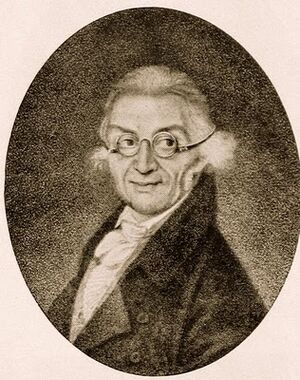Johann Wilhelm Hässler facts for kids
Johann Wilhelm Hässler (born March 29, 1747 – died March 22, 1822) was a talented German musician. He was a composer, which means he wrote music. He was also an amazing organ player and pianist.
A Musician's Life
Johann Hässler was born in a city called Erfurt in Germany. He learned music from his uncle, Johann Christian Kittel. His uncle was also a great organ player in Erfurt.
Johann got his first job as an organist around 1762. He played the organ at a church called Barfüßerkirche. After his father passed away in 1769, Johann also helped manage the family's fur business.
Even with the business, he still traveled a lot for music. In the early 1770s, he went on concert tours around Germany. Later, in the 1780s and 1790s, he toured other parts of Europe.
Meeting Mozart
On one of his tours, on April 15, 1789, Johann Hässler took part in an organ competition. This special event happened in Dresden during Wolfgang Amadeus Mozart's trip to Berlin. Imagine competing against one of the most famous composers ever!
During his travels, Johann also met other important musicians. These included Johann Nikolaus Forkel, Johann Adam Hiller, Franz Benda, and Carl Philipp Emanuel Bach.
From 1790 to 1792, he lived in London. Then he moved to Saint Petersburg in Russia. In 1794, he settled in Moscow. There, he became a well-known music teacher and composer. He stayed in Moscow for the rest of his life.
His Musical Works
Johann Hässler wrote many pieces for keyboard instruments like the piano and organ. These included:
- Sonatas
- Fantasies
- Preludes
His most famous piano piece is the Grand Gigue in D minor, Op. 31. He also wrote a Grand Concert, Op. 50, a cantata (a type of vocal music), chamber music, and songs.
The 360 Preludes
One of Hässler's most interesting works is a huge set of 360 preludes. These are short musical pieces in all different keys. This collection, called Op. 47, was published in 1817.
This massive cycle of music lasts for more than 95 minutes! It was first played in Erfurt on September 23, 2012. It was also performed in Moscow on September 26, 2012. The entire work was recorded in 2017.


